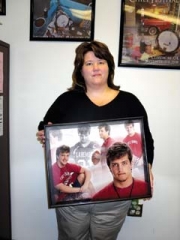Don’t Forget Medicine Cabinets During Spring Cleaning
Prescription drug abuse and misuse is a growing problem in Rogers County and the state of Oklahoma.
By: Cassie Woods | Category: Special Interest | Issue: April 2013

Teresa Dexter holds a photo collage of her son Josh who died from a prescription drug overdose in 2010.
Those looking for drugs no longer have to meet shady dealers in dark street corners. They are getting them right out of the medicine cabinets of their friends and family members.
“Eight out of 10 calls that the Oklahoma Bureau of Narcotics and Dangerous Drugs Control receive are about abuse of prescription drugs,” said Trisha DeLozier, certified prevention specialist for the Healthy Community Partnership.
In 2012, the CDC named Oklahoma as number one in the nation per capita for prescription drug abuse for all ages. In 2011, Oklahoma had 807 fatal and 2,748 non-fatal overdoses. Becoming more dangerous than street drugs, pharmaceutical drugs accounted for 77 percent of Oklahoma’s drug overdoses. Between 1997 and 2007, Rogers County had 68 confirmed overdose deaths.
“According to these numbers, drug overdoses kill more Oklahomans than motor vehicle accidents at an average of two per day,” said Trisha. “The tragedy of drug overdoses forever impacts family and friends.”
As an employee of Claremore High School, Teresa Dexter works with teenagers every day. Her friendly personality makes her a well-loved face on campus. But behind that bright smile is a heart that hurts for teenagers and young adults who struggle with prescription drug abuse. In April of 2010, her son Josh died of a prescription drug overdose, less than six years after she lost another son, Jacob, in a car accident.
“Josh was an All-American teenager,” said Teresa. “He taught swimming lessons, umpired baseball games, was active in sports, made good grades and never missed curfew.”
After graduating from Claremore High School, Josh enrolled at RSU with an honors scholarship. His parents noticed he was having a difficult transition into college life but just thought it was normal growing pains. In December of 2009, Josh lost his scholarship, but because he still had a GPA above 3.0 and was working full time while attending school, Teresa wasn’t terribly alarmed.
“Looking back, all the signs were there.” said Teresa. “Unfortunately we noticed them all as signs of other things. He was a little moody, but we assumed that was because he had to move home after losing his scholarship, which can be a hard transition for a young adult. He had lost some weight, but he wasn’t working out like he had been in high school.”
It was only a couple of weeks before Josh’s death that his parents discovered he had been experimenting with prescription drugs. Teresa’s message to parents is that it truly can happen to anyone, so the only way to prevent a problem is to talk with children about the dangers of prescription drug abuse.
“Education is key, and that responsibility starts with the parents,” said Teresa. “The scariest thing is that people believe that because it comes in a little orange bottle with a doctor’s name on it that it’s safe, but these are dangerous chemicals when not used as prescribed.”
Prescription medications are intended for only the patient named on the bottle. Patients should always follow instructions on their medications, take only as directed by their physician and never share medicine. If you have others who live or visit your home, lock up your prescriptions and remember to properly dispose of them when they expire or are no longer needed.
With the help of Healthy Community Partnership drug drop boxes have been installed at the Claremore, Chelsea and Catoosa Police Departments as well as the Rogers County Sheriff’s Office. Residents can visit any of these locations to safely dispose of unused or unwanted prescription medications.
For more information, search Facebook for Healthy Community Partnership, or call (918) 260-0301.
For more information, contact
Healthy Community Partnership
1700 S. Lynn RiggsClaremore, OK 74017(918) 260-0301
Volunteers for Youth
For more information, contact:
Volunteers for Youth
(918) 343-2530
1810 N. Sioux Ave. Ste. A | Claremore, OK
volunteersforyouth.com
![]()
More about Volunteers for Youth:
More ArticlesCurrent Coupons/OffersSubscribe
For Free!
